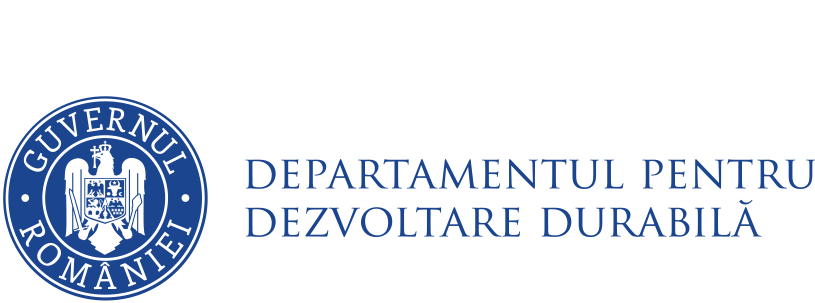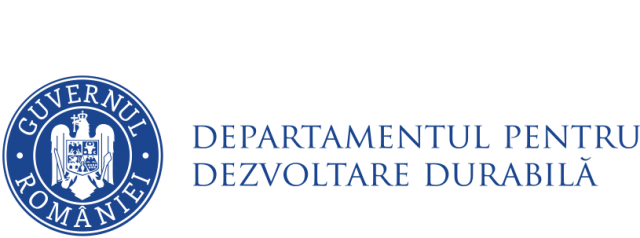The “Atlas of Professions and Competences in Urban Greening” research report aims to create the necessary premises to ensure the high quality of results of a subsequent process to define the future of qualifications, competencies, and training programs needed to develop the field of urban greening. Based on this process, new occupations will be developed, existing ones will be updated, occupational and professional training standards, curriculums, and appropriate training programs will be created.
The report is part of and bears the namesake of the initiative carried out by the Department for Sustainable Development within the General Secretariat of the Government and the WorldSkills Romania Foundation.
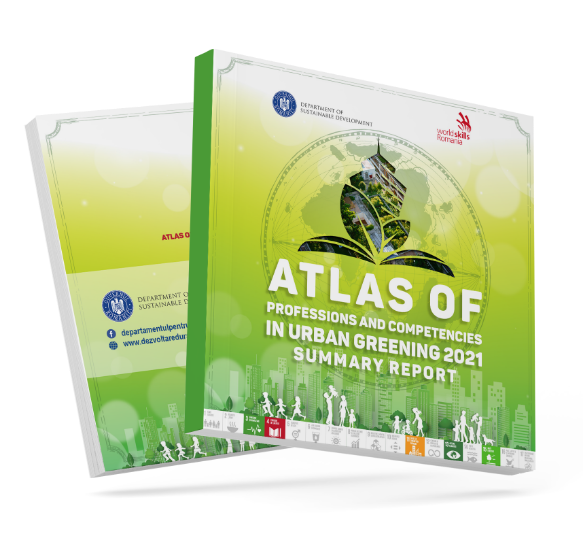
Given the need to identify current professions and competencies, as well as those required for the development of urban greening in Romania, the report focused on the following research topics:
- Analyzing the concept of urban greening from the perspective of various professional fields (architecture, horticulture, landscaping, construction, arboriculture, town planning, human resources, education, social work);
- Mapping the relevant occupations in regards to urban greening, as well as the professional liaison between specialists whose roles are adjacent to urban greening;
- Analyzing relevant competencies and training needs in the field of urban greening.
a. Semi-structured interviews with associations and institutions relevant to the field of urban greening, all of them with extensive professional experience at the national and European level.

By corellating the participants’ answers with the documentation’s analysis, the report has validated the lack of a standard definition for the term urban greening; in general, the concept has been integrated as part of the European Union’s policies on nature-based solutions..
Nature-based solutions provide answers, according to the European Union, to 12 major societal challenges that represent priorities in developing a sustainable society:

Source: European Commission, 2021
Even though the term ”urban greening” is considered new in all the activity fields included in this research, it is often associated with other specific terms and trends.
The perspectives of specialists in the fields addressed in this research are complemented on the one hand by the description of the activities carried and on the other hand, by the new proposals, as directions of progress with an emphasis on urban greening.
These development proposals can represent further research topics and/or can be translated into concrete actions and initiatives at the level of certain organizations or at the level of partnership between several entities.
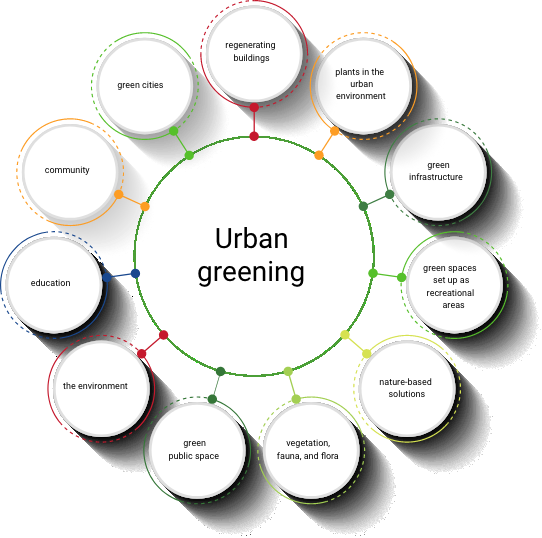
Occupation mapping focused on correlating the Classification of Occupations in Romania (COR) with the European Classification of Skills, Competencies, Qualifications and Occupations (ESCO) in 5 areas considered to be the most relevant from the perspective of urban greening: landscaping, town planning, architecture, construction, and horticulture.
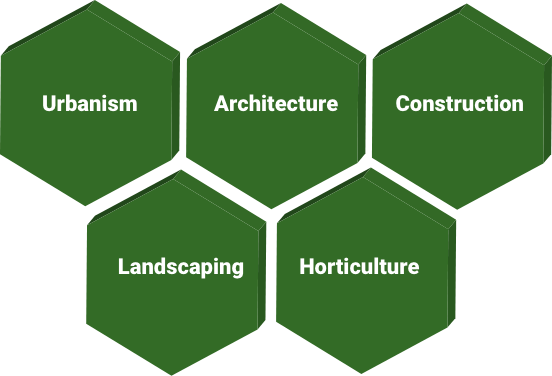
Occupations with overlapping specializations were analyzed in terms of competencies at the European level, as Romania is in the process of aligning occupations to ESCO. Thus, the analysis becomes quite complex, as there are different meanings for the same occupation, many European occupations are subsumed in one, and there are no clear divisions of roles and responsibilities between occupations and/or fields.
At the same time, the specialists that were interviewed stressed the importance of interprofessional collaboration, and the need for integrated & holistic teamwork. They also stressed the importance of expanding to other fields and professions related to urban greening (such as biologists, geographers, economists, political scientists, sociologists).
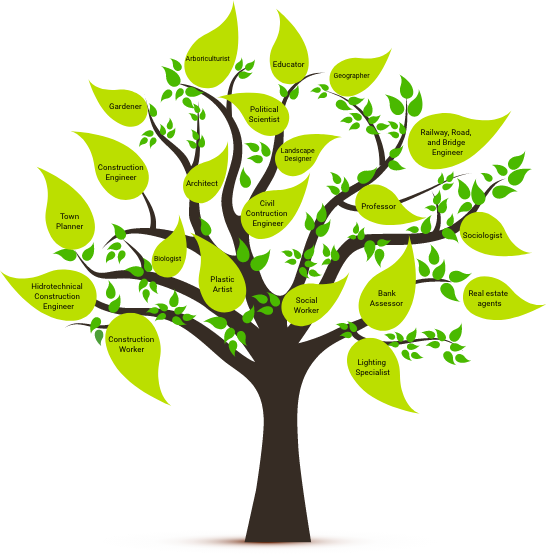
Moreover, changes in the labor market, driven by the emphasis on sustainable development and the green economy, indicate a paradigm shift in what is meant by “green jobs”, in the sense that any profession can go green and thus contribute to the goals that pertain to society’s future. As a future dynamic, existing green industries will be strengthened by the emergence of other green industries, leading to new green occupations and the expansion of existing ones on the market by increasing jobs.
In the same flow of societal dynamics, non-green industries will enter a process of “greening” to a varying degree, influencing the range of competencies and knowledge of existing occupations or replacing occupations that are no longer relevant.
Given this context, we can easily foreshadow the expansion of the number and complexity of occupations that contribute to urban greening. This aspect in itself represents a standalone direction of further research.


Source: Presidential Committee on Green Growth, 2009. Green jobs creation and human resources development strategies

Given that urban greening is currently an area of innovation, in the first stage, the emphasis should be on developing the core competencies adjacent to change, innovation, and the flow of change, especially at the level of managers, decision-makers who trigger, coordinate, and monitor change. Once these competencies have been developed, it makes sense to develop general competencies for implementing the strategy and vision related to urban greening, as well as specific competencies for a clear-cut implementation. Moreover, a clearer definition of the latter may result due to the development of core competencies adjacent to innovation and the flow of change.
The analysis of competencies and knowledge related to occupations in the Classification of Occupations in Romania that are directly equivalent to the European Classification of Skills, Competencies, Qualifications and Occupations (ESCO) indicates the existence of competencies directly related to urban greening – but totally insufficient in relation to European regulations on sustainble development.
Most often, the competencies directly related to urban greening refer to aspects related to green infrastructure (vegetation, plants, trees, lawn, green spaces, flora, fauna, water), but do not include references to its specificity in the urban environment. Some occupations also include aspects related to pollution, ecology, sustainability, environment, protection, conservation, climate change, however, except for the urban planner, the competencies and knowledge associated with other occupations do not include elements specific to the urban environment.
At the same time, updating the competencies that can support urban greening is a laborious process, which involves more extensive research in terms of period, theme, methods, and the number of subjects that should be interviewed. This may be the subject of a later step to continue this initiative (which has identified the current situation of reflecting on competencies directly related to urban greening and perceptions about the need for new competencies to support the development of this area).

Moreover, the specialists that are involved in this process highlight the need for training for the development of competencies in the field of urban greening, at several levels and for several fields, opening multiple perspectives that require further analysis at the later stages of this research, in close connection with the competencies that will become more clearly defined.
Thus, new information and training programs become necessary. The continuous character of training is an essential aspect, as the dynamics of the field’s development happen quickly. Furthermore, the interdisciplinarity of the courses that will take place is crucial in order to ensure a high quality of services.
1. Interdisciplinary teams from different fields are needed to support the development of the field of urban greening. The composition of these interdisciplinary teams and the relations between their members, as well as the opportunity for new occupations, is another thing that needs better clarification, given the different perspectives of research participants (representatives of several professional associations).
2. In the specific activities in the fields of landscaping, architecture, town planning, constructions, and horticulture, there are elements of urban greening, but it is necessary to add new activities to allow the development of the field. Representatives of professional associations that participated in the research identified new initiatives that can support the development of this field, which require further analysis.
3. Extensive research is needed to update skills and competencies that support urban greening, given the complexity and dynamics of the European and national labor market, as well as the different perspectives of research participants that would require further analysis, through a collaborative approach.



